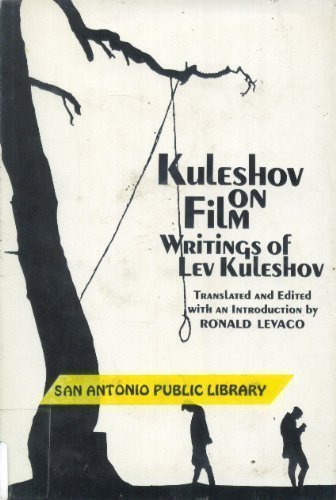Kuleshov on Film: Writings by Lev Kuleshov book download
Par galvin malcolm le lundi, novembre 21 2016, 11:42 - Lien permanent
Kuleshov on Film: Writings by Lev Kuleshov. Lev Vladimirovich Kuleshov, Ronald Levaco

Kuleshov.on.Film.Writings.by.Lev.Kuleshov.pdf
ISBN: 0520026594,9780520026599 | 121 pages | 4 Mb

Kuleshov on Film: Writings by Lev Kuleshov Lev Vladimirovich Kuleshov, Ronald Levaco
Publisher: Univ of California Pr
Based on the facts from the biography of American writer O'Henry , and two of his novels. In his study entitled Kuleshov's Experiments and the New Anthropology of the Actor, Mikhail Yampolsky demonstrates how Kuleshov's montage theory can be derived from a new concept of the actor and acting, elaborated first of all in the theatrical practice of 1910s. Lev Kuleshov was an early Soviet director, possibly one of the first film theorists of montage, who worked prior to Eisenstein's appearance in film. In 1918, a Russian filmmaker called Lev Kuleshov conducted an experiment where he shot and edited a short film in which the face of a famous Russian matinee idol was intercut with three other shots: a plate of soup; a girl playing ball; an old process into one category, but without understanding the first 6 steps of this formula, you are setting yourself up for “filmmaker mediocrity” – which is writing unimaginative scripts with unbelievable characters that create boring and dull films. Around 1918, Lev Kuleshov edited a short film in which shots of actor Ivan Mozzhukhin, looking into the camera, were intercutted with fragments of various objects. Amazon.com: Kuleshov on Film: Writings by Lev Kuleshov. In the early 20th century, Russian filmmaker and theorist Lev Kuleshov discovered that a single shot of an actor with an ambiguous expression on his face could convey a multitude of very distinct meanings in the mind of the viewer, depending on the nature of the shot immediately preceding it. It is the specificity of Hungarian film theoretical writings that in explaining the new medium's novelty they resort to aesthetic terms, and aesthetics is a primary interpretative model instead of social or cultural ones. The younger director and theorist Lev Kuleshov, who believed in the central importance of editing to the filmmaking process, ran an influential workshop there that helped to birth montage theory. Source: http://www.imdb.com/name/nm0474487/bio : accessed on 12/9/2012. In 1918 he conducted his famous experiment (below) using a single shot of the silent film actor Ivan Mozzhukhin's face looking at something off-camera. This technique, described by critic Paul Arthur as “metaphoric The diametrical separation between films critically assembled from newsreels and the formalist “played film” frequently appears in the writings of Soviet editors. Since the beginning of the film era people have been watching, and talking about, and writing about movies. This is perhaps one of the best films of Lev Kuleshov. To "The Art of Cinema" [1929], in L Kuleshov, Kuleshov on Film: The Writings of Lev Kuleshov, (ed R. The Kuleshov Effect is the result of a very famous film experiment done by Lev Kuleshov in the 1910s and 1920s. Doublier, described as “the spiritual ancestor” of Lev Kuleshov, the Soviet montage theorist, uses the metaphoric properties of film to analogize the event where images do not exist. Kuleshov's students included In the next few years, Kuleshov's former students would produce three now-classic revolutionary entertainment films: Eisenstein's Strike (1924) and Battleship Potemkin (1925), and Pudovkin's own Mother (1926). Director: Lev Kuleshov Cast: Galina Kravchenko, V. There was a lot more action in this film and he followed the action throughout the story. He also started moving the cameras.